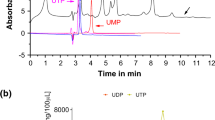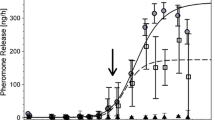Abstract
The work of Kazutsugu Hirayama over the past 25 yearspromoted the wide use of the marine rotifer Brachionusplicatilis as an experimental model in zooplanktonecology. His reports about the nature of geneticvariation in the B. plicatilis complex stimulated usto investigate how mate recognition maintains speciesboundaries. For the past several years, we haveexamined chemical communication between female andmale B. plicatilis. Here we report on the comparativebinding of polyclonal antibody against the materecognition pheromone (MRP) to three B. plicatilisstrains and three B. rotundiformis strains.Quantification of anti-MRP binding permitsinvestigation of how the female mating signal differsamong closely related Brachionus species and strains.Antibody binding reflects differentiation independentof the male receptor which has been describedelsewhere. Anti-MRP bound to females of all sixstrains and was localized in the corona. Antibodybinding greatly reduced mating in all three B. plicatilis strains. However, antibody bindingsignificantly reduced mating in only one of the B. rotundiformis strains. The MRP of both species has asimilar molecular weight, but the differential bindingsuggests that the mate recognition pheromone onfemales has differentiated in B. plicatilis and B. rotundiformis.
Similar content being viewed by others
References
Fu, Y. & K. Hirayama, 1990. Strains of the rotifer Brachionus plicatilis having particular patterns of isozymes. Proceedings of the Second Asian Fisheries Forum: 177–180.
Fu, Y., K. Hirayama & Y. Natsukari, 1991a. Morphological differences between two types of the rotifer Brachionus plicatilis. J. exp. mar. Biol. Ecol. 151: 29–41.
Fu, Y., K. Hirayama & Y. Natsukari, 1991b. Genetic differences between S and L type strains of the rotifer Brachionus plicatilis. J. exp. mar. Biol. Ecol. 151: 43–56.
Fu, Y., A. Hagiwara & K. Hirayama, 1993. Crossing between seven strains of the rotifer Brachionus plicatilis. Nippon Suisan Gakkaishi 59: 2009–2016.
Gómez, A. & M. Serra, 1995. Behavioral reproductive isolation among sympatric strains of Brachionus plicatilisMüller 1786: insights into the status of this taxonomic species. Hydrobiologia 313/314: 111–119.
Palumbi, S. R., 1994. Genetic divergence, reproductive isolation, and marine speciation. Ann. Rev. Ecol. Syst. 25: 547–572.
Rico-Martónez, R. & T. W. Snell, 1995a. Mating behavior and mate recognition pheromone blocking of male receptors in Brachionus plicatilisMuller (Rotifera). Hydrobiologia 313/314: 105–110.
Rico-Martínez, R. & T. W. Snell, 1995b. Male discrimination of female Brachionus plicatilisand Brachionus rotundiformis Tschugunoff (Rotifera). J. exp. mar. Biol. Ecol. 190: 39–49.
Rico-Martínez, R., 1996. Contribution to the Knowledge of Speciation in the Rotifera. Ph.D. dissertation, Georgia Institute of Technology, Atlanta, Georgia. UMI #9614135.
Rumengan, I. F. M. & K. Hirayama, 1990. Growth responses of genetically distinct S and L type rotifer (Brachionus plicatilis) strains to different temperatures. Proceedings of Second Asian Fisheries Forum: 37–40.
Rumengan, I. F. M., H. Kayano & K. Hirayama, 1991. Karyotypes of S and L type rotifers Brachionus plicatilisO. F. Müller. J. exp. mar. Biol. Ecol. 154: 171–176.
Segers, H., 1995. Nomenclature consequences of some recent studies on Brachionus plicatilis(Rotifera, Brachionidae). Hydrobiologia 313/314: 121–122.
Snell, T. W. & C. A. Hawkinson, 1983. Behavioral reproductive isolation among populations of the rotifer Brachionus plicatilis. Evolution 37: 1294–1305.
Snell, T. W. & F. H. Hoff, 1987. Fertilization and male fertility in the rotifer Brachionus plicatilis. Hydrobiologia 147: 329–334.
Snell, T. W., P. D. Morris & G. Cecchine, 1993. Localization of the mate recognition pheromone Brachionus plicatilisO. F. Müller (Rotifera) by fluorescent labeling with lectins. J. exp. mar. Biol. Ecol. 165: 225–235.
Snell, T. W., R. Rico-Martínez, L. N. Kelly & T. E. Battle, 1995. Identification of a sex pheromone from a rotifer. Mar. Biol. 123: 347–353.
Sokal, R. R. & F. J. Rohlf, 1981. Biometry (2nd edn). W. H. Freeman & Co., San Francisco, 776 pp.
Author information
Authors and Affiliations
Rights and permissions
About this article
Cite this article
Rico-Martínez, R., Snell, T.W. Comparative binding of antibody to a mate recognition pheromone on female Brachionus plicatilis and Brachionus rotundiformis (Rotifera). Hydrobiologia 358, 71–76 (1997). https://doi.org/10.1023/A:1003121531835
Issue Date:
DOI: https://doi.org/10.1023/A:1003121531835




